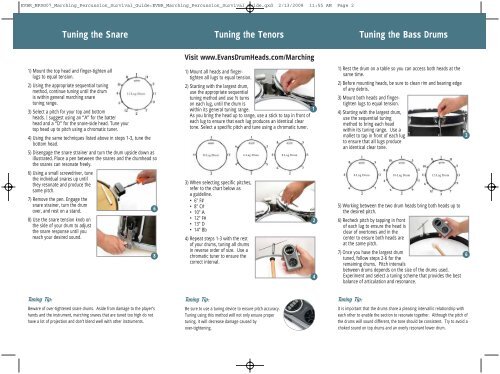Marching Percussion Survival Guide by Jim Bailey - Evans ...
Marching Percussion Survival Guide by Jim Bailey - Evans ...
Marching Percussion Survival Guide by Jim Bailey - Evans ...
Create successful ePaper yourself
Turn your PDF publications into a flip-book with our unique Google optimized e-Paper software.
EVBR_MPSG07_<strong>Marching</strong>_<strong>Percussion</strong>_<strong>Survival</strong>_<strong>Guide</strong>:EVBR_<strong>Marching</strong>_<strong>Percussion</strong>_<strong>Survival</strong>_<strong>Guide</strong>.qxd 2/13/2008 11:55 AM Page 2<br />
Tuning the Snare Tuning the Tenors Tuning the Bass Drums<br />
Visit www.<strong>Evans</strong>DrumHeads.com/<strong>Marching</strong><br />
1) Mount the top head and finger-tighten all<br />
lugs to equal tension.<br />
2) Using the appropriate sequential tuning<br />
method, continue tuning until the drum<br />
is within general marching snare<br />
tuning range.<br />
3) Select a pitch for your top and bottom<br />
heads. I suggest using an “A” for the batter<br />
head and a “D” for the snare-side head. Tune your<br />
top head up to pitch using a chromatic tuner.<br />
4) Using the same techniques listed above in steps 1-3, tune the<br />
bottom head.<br />
5) Disengage the snare strainer and turn the drum upside down as<br />
illustrated. Place a pen between the snares and the drumhead so<br />
the snares can resonate freely.<br />
6) Using a small screwdriver, tune<br />
the individual snares up until<br />
they resonate and produce the<br />
same pitch.<br />
7) Remove the pen. Engage the<br />
snare strainer, turn the drum<br />
over, and rest on a stand.<br />
6<br />
8) Use the snare tension knob on<br />
the side of your drum to adjust<br />
the snare response until you<br />
reach your desired sound.<br />
1) Mount all heads and fingertighten<br />
all lugs to equal tension.<br />
2) Starting with the largest drum,<br />
use the appropriate sequential<br />
tuning method and use ½ turns<br />
on each lug, until the drum is<br />
within its general tuning range.<br />
1<br />
As you bring the head up to range, use a stick to tap in front of<br />
each lug to ensure that each lug produces an identical clear<br />
tone. Select a specific pitch and tune using a chromatic tuner.<br />
6-Lug Drum<br />
8-Lug Drum<br />
1) Rest the drum on a table so you can access both heads at the<br />
same time.<br />
2) Before mounting heads, be sure to clean rim and bearing edge<br />
of any debris.<br />
3) Mount both heads and fingertighten<br />
lugs to equal tension.<br />
4) Starting with the largest drum,<br />
use the sequential tuning<br />
method to bring each head<br />
within its tuning range. Use a<br />
mallet to tap in front of each lug<br />
to ensure that all lugs produce<br />
an identical clear tone.<br />
3<br />
8<br />
3) When selecting specific pitches,<br />
refer to the chart below as<br />
a guideline.<br />
• 6" F#<br />
• 8" C#<br />
• 10" A<br />
• 12" F#<br />
• 13" D<br />
• 14" Bb<br />
4) Repeat steps 1-3 with the rest<br />
of your drums, tuning all drums<br />
in reverse order of size. Use a<br />
chromatic tuner to ensure the<br />
correct interval.<br />
2<br />
4<br />
8-Lug Drum 10-Lug Drum 12-Lug Drum<br />
5) Working between the two drum heads bring both heads up to<br />
the desired pitch.<br />
6) Recheck pitch <strong>by</strong> tapping in front<br />
of each lug to ensure the head is<br />
clear of overtones and in the<br />
center to ensure both heads are<br />
at the same pitch.<br />
7) Once you have the largest drum<br />
tuned, follow steps 2-6 for the<br />
remaining drums. Pitch intervals<br />
between drums depends on the size of the drums used.<br />
Experiment and select a tuning scheme that provides the best<br />
balance of articulation and resonance.<br />
6<br />
Tuning Tip:<br />
Beware of over-tightened snare drums. Aside from damage to the player’s<br />
hands and the instrument, marching snares that are tuned too high do not<br />
have a lot of projection and don’t blend well with other instruments.<br />
Tuning Tip:<br />
Be sure to use a tuning device to ensure pitch accuracy.<br />
Tuning using this method will not only ensure proper<br />
tuning, it will decrease damage caused <strong>by</strong><br />
over-tightening.<br />
Tuning Tip:<br />
It is important that the drums share a pleasing intervallic relationship with<br />
each other to enable the section to resonate together. Although the pitch of<br />
the drums will sound different, the tone should be consistent. Try to avoid a<br />
choked sound on top drums and an overly resonant lower drum.




